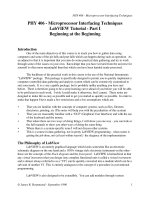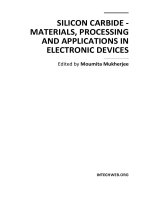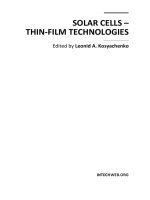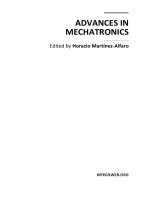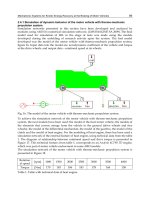Proteomic Applications in Biology Part 1 docx
Bạn đang xem bản rút gọn của tài liệu. Xem và tải ngay bản đầy đủ của tài liệu tại đây (424.79 KB, 17 trang )
PROTEOMIC
APPLICATIONS
IN BIOLOGY
Edited by Joshua L. Heazlewood
and Christopher J. Petzold
Proteomic Applications in Biology
Edited by Joshua L. Heazlewood and Christopher J. Petzold
Subject Editors: Tsz-Kwong Man and Ricardo J. Flores
Published by InTech
Janeza Trdine 9, 51000 Rijeka, Croatia
Copyright © 2011 InTech
All chapters are Open Access distributed under the Creative Commons Attribution 3.0
license, which allows users to download, copy and build upon published articles even for
commercial purposes, as long as the author and publisher are properly credited, which
ensures maximum dissemination and a wider impact of our publications. After this work
has been published by InTech, authors have the right to republish it, in whole or part, in
any publication of which they are the author, and to make other personal use of the
work. Any republication, referencing or personal use of the work must explicitly identify
the original source.
As for readers, this license allows users to download, copy and build upon published
chapters even for commercial purposes, as long as the author and publisher are properly
credited, which ensures maximum dissemination and a wider impact of our publications.
Notice
Statements and opinions expressed in the chapters are these of the individual contributors
and not necessarily those of the editors or publisher. No responsibility is accepted for the
accuracy of information contained in the published chapters. The publisher assumes no
responsibility for any damage or injury to persons or property arising out of the use of any
materials, instructions, methods or ideas contained in the book.
Publishing Process Manager Martina Durovic
Technical Editor Teodora Smiljanic
Cover Designer InTech Design Team
Image Copyright Photographer - Yves Verhertbruggen
First published January, 2012
Printed in Croatia
A free online edition of this book is available at www.intechopen.com
Additional hard copies can be obtained from
Proteomic Applications in Biology, Edited by Joshua L. Heazlewood and
Christopher J. Petzold; Subject Editors: Tsz-Kwong Man and Ricardo J. Flores
p. cm.
ISBN 978-953-307-613-3
free online editions of InTech
Books and Journals can be found at
www.intechopen.com
Contents
Preface IX
Part 1 Addressing Issues in Agriculture 1
Chapter 1 Food Proteomics: Mapping Modifications 3
Stefan Clerens, Jeffrey E. Plowman and Jolon M. Dyer
Chapter 2 Fruit Proteomics 33
Ariel Orellana and Ricardo Nilo
Chapter 3 Understanding the Pathogenesis of Cytopathic
and Noncytopathic Bovine Viral Diarrhea
Virus Infection Using Proteomics 53
Mais Ammari, Fiona McCarthy, Bindu Nanduri,
George Pinchuk and Lesya Pinchuk
Part 2 Studying Environmental Complexities 67
Chapter 4 Proteomics as a Tool for the Characterization
of Microbial Isolates and Complex Communities 69
Florence Arsène-Ploetze, Christine Carapito,
Frédéric Plewniak and Philippe N. Bertin
Chapter 5 Life in the Cold: Proteomics of
the Antarctic Bacterium Pseudoalteromonas haloplanktis 93
Florence Piette, Caroline Struvay,
Amandine Godin, Alexandre Cipolla and Georges Feller
Part 3 Diverse Impacts in Plant Proteomics 115
Chapter 6 Plant Protein Analysis 117
Alessio Malcevschi and Nelson Marmiroli
Chapter 7 Assessment of Proteomics Strategies for Plant Cell Wall
Glycosyltransferases in Wheat, a Non-Model Species:
Glucurono(Arabino)Xylan as a Case Study 143
Faik Ahmed
VI Contents
Chapter 8 The Current State of the Golgi Proteomes 167
Harriet T. Parsons, Jun Ito, Eunsook Park, Andrew W. Carroll,
Hiren J. Joshi, Christopher J. Petzold, Georgia Drakakaki
and Joshua L. Heazlewood
Part 4 Comparative Approaches in Biology 189
Chapter 9 Differentiation of Four Tuna Species by Two-Dimensional
Electrophoresis and Mass Spectrometric Analysis 191
Tiziana Pepe, Marina Ceruso, Andrea Carpentieri, Iole Ventrone,
Angela Amoresano, Aniello Anastasio
and Maria Luisa Cortesi
Chapter 10 Identification of Proteins Involved in pH Adaptation
in Extremophile Yeast Yarrowia lipolytica 209
Ekaterina Epova, Marina Guseva, Leonid Kovalyov,
Elena Isakova, Yulia Deryabina, Alla Belyakova,
Marina Zylkova and Alexei Shevelev
Chapter 11 The Role of Conventional Two-Dimensional
Electrophoresis (2DE) and Its Newer
Applications in the Study of Snake Venoms 225
Jaya Vejayan, Mei San Tang and Ibrahim Halijah
Chapter 12 Protein Homologous to Human CHD1, Which Interacts
with Active Chromatin (HMTase) from Onion Plants 253
DongYun Hyun and Hong-Yul Seo
Preface
In the past decade the field of proteomics has expanded from a highly technical
endeavor requiring dedicated practitioners to being widely utilized by researchers of
diverse backgrounds for solving complex problems in biology. The approach is used
broadly to complement basic molecular and biochemical research and encompasses
basic protein identification, functional characterization, comparative approaches and
large-scale analyses. During this period, technical improvements (e.g., increased
sensitivity, speed, mass accuracy, dynamic range) in mass spectrometric
instrumentation provided a solid foundation for proteomic applications outlined in
this collection.
This book is divided into four sections and is an interesting overview of the diversity
and breadth of proteomic applications in biology. This is highlighted by the wide
range of plant, animal and microbial species that are presented throughout the
contents of this volume. Especially interesting are the variety of proteomic methods
and analytical strategies employed by biological researchers. The technical side of
proteomics has witnessed enormous changes in sample analysis strategies with many
advanced users adopting ‘shotgun’ approaches for protein identification and
quantification. In contrast, many of the studies outlined in this book employ
established, but still powerful, two-dimensional gel electrophoresis strategies to array
samples prior to protein identification and/or quantification. The advantages of such a
visual media for assessment prior to identification are that they are useful and
productive when access to high-end mass spectrometers is limited.
The first section of this book outlines the utilization of proteomics to address issues in
agriculture. The increased pressure on food production in the coming decades due to
expanding populations and the effects of climate change will require major re-
assessments of how food is produced. It is extremely likely that proteomic approaches
in combination with other analysis techniques will play an important role in the
adaptation of this industry through agricultural research. The chapters outlined in this
section cover the utilization and application of proteomics to assess the effects of
unintended post-translational modifications on food-derived proteins, an overview of
approaches and techniques to examine proteins from fruit, and the use of proteomic
techniques to understand viral pathogenesis in cattle.
X Preface
The second section focuses on the emerging role of metaproteomics to characterize
and profile microbes and microbial communities. The majority of the Earth’s biomass
is comprised of microorganisms, many of which play essential roles in recycling
elements such as carbon and nitrogen. While our knowledge of these complex
communities is still very limited, recent advances in sequencing technologies, and now
proteomics, enable detailed examination of these interesting populations. This section
provides an overview of current proteomic approaches and methods being used to
study microbial communities, demonstrating the utilization of these approaches to
characterize a cold tolerant bacterial strain from the Antarctic.
The third section addresses the utilization of proteomics to study fundamental
processes in plants. The development of novel approaches and processes using
proteomics can be a direct driver for applications in other areas of biology and applied
research. This section highlights the specific issues associated with undertaking
proteomic analyses in plant biology, demonstrates and assesses its use in
understanding the complex process of plant cell wall biosynthesis through a targeted
characterization of xylan biosynthesis using multiple approaches by mass
spectrometry and finally provides an overview of the subcellular isolation and
proteomic characterization of the Golgi apparatus from plants and other species.
The final section highlights the use of comparative proteomics in biology to
understand complex systems. One of the most significant contributions to the field of
proteomics has been the development of reliable and reproducible quantitation
techniques enabling comparative profiling of samples to be undertaken. This section
examines the use of proteomics to identify protein markers to differentiate commercial
tuna species, to identify proteins involved in pH adaptation in yeast strains, the
characterization and identification of proteins in snake venom and lastly, the
identification and characterization of a protein from onion involved in floral bolting.
Collectively these chapters outline studies and overviews that employ a wide variety
of proteomic applications in biology. These approaches display extensive technical
diversity and contrast the use of proteomics from the community level to the
individual protein and together highlight the varied ways in which proteomics is
being used to expand our understanding of biological systems.
Dr. Joshua L. Heazlewood
and Dr. Christopher J. Petzold
Joint BioEnergy Institute and Physical Biosciences Division
Lawrence Berkeley National Laboratory
Berkeley California,
USA
Part 1
Addressing Issues in Agriculture
1
Food Proteomics: Mapping Modifications
Stefan Clerens
1
, Jeffrey E. Plowman
1
and Jolon M. Dyer
1,2,3
1
Food & Bio-Based Products, AgResearch Lincoln Research Centre
2
Biomolecular Interaction Centre, University of Canterbury
3
Riddet Institute at Massey University, Palmerston North
New Zealand
1. Introduction
Proteins are an essential element in the human diet. As food ingredients, they are primarily
sourced from plants and animals; important sources include cereals, meat, poultry, fish and
dairy. Proteomics offers a powerful new way to characterise the protein component of foods.
Proteomics not only reveals which proteins are expressed in each tissue type, it also allows the
investigation of differences in the protein composition of different tissues. In addition it has
the power to track the proteome of tissues before and after harvest/slaughter, and to evaluate
the effect of downstream treatments such as cooking or curing.
The proteomic evaluation of food proteins presents a unique set of challenges and
opportunities. Muscle, milk and cereal proteomes are dominated by very abundant proteins,
creating a dynamic range problem. In addition to post-translational modifications produced
in vivo, food proteins are subjected to a wide range of post-harvest/post-slaughter
environmental and processing insults prior to consumption. These modifications include
side-chain oxidation, cross-link formation and backbone cleavage, and critically influence
key food properties such as shelf-life, nutritional value, digestibility and health effects.
A profound understanding of proteomics, protein modifications and redox chemistry has
allowed us to pioneer the application of redox proteomics to foods. This has led to the
development of a unique proteomics damage scoring system, allowing a direct link between
molecular-level understanding to intervention/mitigation at the processing level (Dyer et
al., 2010). We anticipate that this ability will be pivotal in the development of next-
generation food products.
This chapter outlines current achievements in the field of food proteomics. It deals with the
full spectrum of protein-containing foods, including dairy, meat, seafood and cereal
proteins. We focus on ex vivo protein modifications and their effects on foods. We devote
attention to redox proteomics approaches applied to food, and pay special attention to the
recent development of advanced redox proteomic-based approaches to evaluate and track
food protein modifications. These approaches are illustrated in a case study that compares
the protein damage level in a number of commercially available dairy products.
2. Proteins and nutrition
Proteins are key functional and structural components of all living cells and are an essential
element in the human diet. The human body is capable of synthesising most of the amino
Proteomic Applications in Biology
4
acids from other precursors, but is unable to produce the nine essential amino acids (His, Ile,
Leu, Lys, Met, Phe, Thr, Trp, Val), which must be supplied from the diet. Another six amino
acids (Arg, Cys, Gln, Gly, Pro, Tyr) can be produced by the body, but may need a dietary
source when endogenous production cannot meet metabolic requirements. Amino acids also
act as precursors for many coenzymes, hormones, nucleic acids and other molecules, and
can also be used as a metabolic fuel.
The total amount of protein in the body is fairly static, but individual proteins are constantly
being degraded and re-synthesised. The rate of this turnover is affected by stage of life and
level of activity. That makes the inclusion of an appropriate quantity of high quality protein
in the diet critical for growth and development in children and the maintenance of good
health in adults.
Protein can be sourced from plants and animals; important sources include cereals, meat,
poultry, fish and dairy foods. These sources differ in the relative bioavailability of protein
and, in particular, essential amino acids. In general the digestibility of proteins from
vegetable sources is lower than for those of animal origin, being around 78-85% as opposed
to 94-97% for meat, dairy and eggs. Animal sources of protein also generally have higher
levels of the essential amino acids.
Proteomics, through the application of gel and non-gel approaches, offers a powerful new
way to characterise the protein component of foods. Whereas genomics provides
information on the total genome of the organism, proteomics reveals which proteins are
actually expressed in each tissue type. Furthermore the application of proteomic techniques
offers a way to investigate differences in the protein composition of different tissues within
a specific animal or vegetable food type, as well as between different varieties of it. In
addition it has the power to follow changes in the protein component of various tissues
during growth, maturation and post-mortem or post-harvest, as well as downstream
treatments such as cooking.
3. Food proteomics
This section overviews and summarises the application of classical proteomics in food
science, broken down into major food protein groups.
3.1 Dairy
Proteomics has been successfully applied to the study of milk proteins by many research
teams, and significant effort has gone into the characterisation of the milk proteome. Also,
bioactive milk components are of enormous scientific and commercial interest. Proteomics
approaches have been used to compare milk from different species, while proteomic
evaluation of other dairy products such as cheese has been a specialist subject that has also
received attention.
In general, the dynamic range of proteins in milk poses a challenge to proteomics
technologies. This is because the proteins in milk tend to be dominated by the caseins, which
make up some 80% of the total protein content. Even when these are removed, the minor
components in whey are dominated by one or two proteins; in bovine milk these are α-
lactalbumin and β-lactoglobulin. Dynamic range issues have been overcome thanks to
improvements in mass spectrometer sensitivity, coupled with the application of depletion
and/or fractionation techniques. Casein, for example, is easily removed by acid
precipitation. Alternatively affinity purification has been successfully used to remove IgA,
Food Proteomics: Mapping Modifications
5
lactoferrin, α-lactalbumin and serum albumin from human colostrum, allowing the
identification of 151 proteins, over half of which have not been previously identified in
colostrum or in milk (Palmer et al., 2006).
Following fractionation, substantial attention has been given to the identification of minor
(including bioactive) components in milk. In one study 2-dimensional electrophoretic (2-DE)
proteomic methods were applied to bovine whey after it had been fractionated into acidic,
basic and non-bound components by semi-coupled anion and cation exchange
chromatography (Fong et al., 2008). Utilising this approach, a large number of minor whey
proteins were identified, some of which had not been previously reported in milk; in
particular the acidic fraction was found to have a group of osteopontin peptides. Other
investigators have used proteomics approaches to compare milk from different species to
evaluate their suitability as a substitute for human milk (D'Auria et al., 2005).
Discovery and characterisation of bioactive milk components is of enormous scientific and
commercial interest. For example, the host defence proteins in milk and colostrum have the
potential to add significant value to the dairy industry, and techniques have been put in
place to fractionate and analyse them using proteomics (Smolenski et al., 2007; Stelwagen et
al., 2009).
The milk fat globule membrane (MFGM) constitutes another important component of milk.
MFGM composition is of interest because it is known to be rich in bioactive components and
there is increasing evidence that there are significant health benefits associated with the
consumption of MFGM. Vanderghem et al. (2008), investigating a simple and rapid
approach for the extraction of the MFGM, evaluated a number of different detergents and
found that the inclusion of 4% CHAPS resulted in the removal of the highest amount of
skim milk proteins as evaluated by 2-DE. Affolter et al. (2010) profiled two fractions of the
MFGM, a whey protein concentrate (WPC) and a buttermilk protein concentrate (BPC)
using three different approaches. Using a LC-MS/MS shotgun proteomics approach, 244
proteins were identified in WPC and 133 in BPC, while label-free profiling was used for
semi-quantitative profiling and the determination of protein fingerprints.
Water soluble extracts of Teleme cheeses prepared from ovine, caprine and bovine milk
were separated by 2-D gel electrophoresis and analysed by MALDI-MS and by HPLC in
conjunction with Edman degradation, MS and tandem MS (Pappa et al., 2008). The 2-DE
gels tended to be dominated by the casein and whey proteins, while in the MS analysis of
the RP-HPLC-separated peptide fractions a few predominant peptides tended to mask the
minor components. Nevertheless, enough differences were observed to enable the source of
milk to be identified. Species specific differences were also observed in the tandem MS of
peptides originating from casein. The effect of variations in milk protein composition on
cheese yield of chymosin-separated sweet whey and casein fractions was examined by 2-D
electrophoresis in conjunction with MS and multivariate data analysis (Wedholm, 2008).
Using this approach it was possible to identify a range of proteins which had a significant
effect on the transfer of proteins from milk to cheese. Included among these was a C-
terminal fragment of β-casein, as well as a combination of several other minor fragments of
β-, αs1 and αs-2 caseins, whose individual effect was relatively low.
3.2 Meat
The field of meat proteomics has seen steady growth over the past five years. A large
number of studies have been performed, with a few distinct categories emerging. The post
mortem conversion of muscle into meat is a significant series of events connected with
